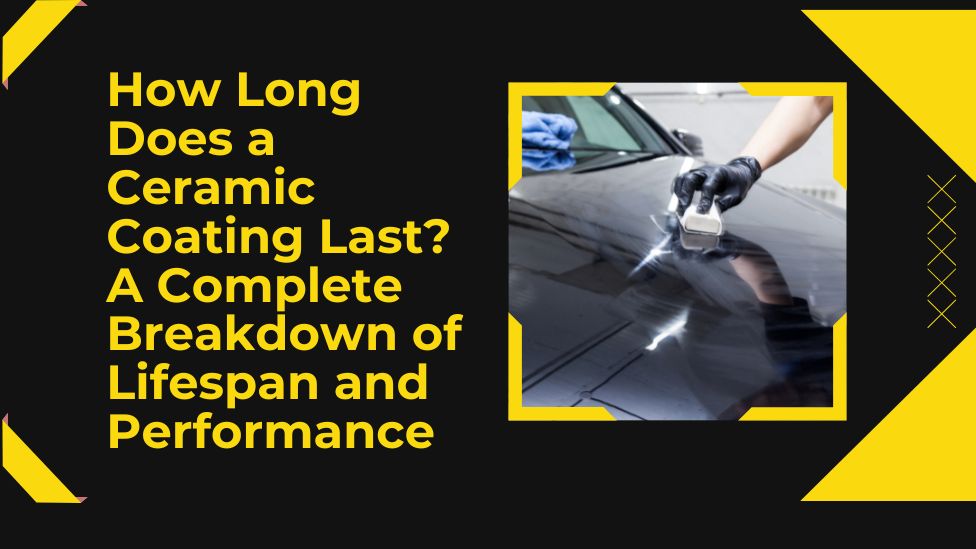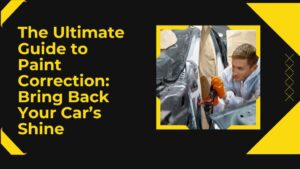Introduction
Ceramic coating has become a go-to solution for car owners seeking long-term paint protection with minimal upkeep. But a key question remains: how long does a ceramic coating really last? While ceramic coatings are celebrated for their durability and glossy finish, several factors influence their actual lifespan. In this guide, we’ll explore what affects longevity, how to tell when it’s wearing out, and how to keep your coating performing its best.
What Is Ceramic Coating?
Ceramic coating is a liquid-based protective layer that chemically bonds with your vehicle’s clear coat. Once cured, it forms a durable shield that guards against environmental contaminants like UV rays, acid rain, bird droppings, and road grime.
Unlike wax or sealants, ceramic coatings offer semi-permanent protection, enhanced hydrophobicity, and an unmistakable deep gloss that elevates your car’s look while making cleaning easier.
Expected Lifespan of Ceramic Coatings
The durability of ceramic coatings varies depending on the type of product, installation method, and care regimen. Here’s a general idea of how long you can expect different types to last:
- Basic Coatings: Typically last 1–2 years, often applied by DIY users with minimal prep.
- Mid-Tier Coatings: Applied professionally with surface correction and multiple layers; usually last 2–5 years.
- Advanced Coatings: Premium-grade formulas applied by certified installers, often backed by extended warranties, can last anywhere from 5 to 10 years or more.
Keep in mind that even the highest-end coatings rely on consistent care to deliver peak performance throughout their life cycle.
Key Factors Influencing Ceramic Coating Longevity
Several elements determine how long your ceramic coating will last. Understanding these helps ensure better performance and a longer-lasting finish.
1. Product Quality
Top-tier coatings contain higher levels of silicon dioxide (SiO₂), which increases hardness and chemical resistance. Some blends include titanium dioxide (TiO₂) for additional UV protection.
2. Surface Preparation
Proper prep work is essential. This includes washing, decontamination (iron remover, clay bar), and paint correction. A coating applied to unprepared surfaces will not adhere properly, shortening its lifespan.
3. Application Technique
Professional installation generally leads to more uniform coverage and better bonding. DIY applications can work, but they’re often less durable due to application errors or skipped prep steps.
4. Environmental Exposure
Cars stored in garages and driven in mild climates will retain their coating longer than those exposed to extreme sun, pollution, road salt, or acid rain.
5. Maintenance Habits
How you wash and maintain your car makes a big difference. Using the wrong products or techniques can degrade the coating prematurely.
Signs Your Ceramic Coating Is Wearing Out
Even high-quality coatings eventually degrade. Watch for these signs:
- Reduced Hydrophobic Behavior: If water no longer beads or sheets off, the coating may be losing effectiveness.
- Dull Appearance: A faded or flat look often indicates diminished protection.
- Faster Dirt Accumulation: Dirt sticking more easily may signal weakened surface slickness.
These symptoms suggest it might be time for a maintenance treatment or reapplication.
How to Prolong the Life of Your Ceramic Coating
Want to get the most out of your ceramic coating? Follow these expert tips:
✅ Use the Two-Bucket Wash Method
Reduces the risk of swirl marks by minimizing dirt transfer.
✅ Stick to pH-Neutral Products
Avoid harsh chemicals that can strip or weaken the coating.
✅ Incorporate Maintenance Boosters
Periodic use of ceramic-enhancing sprays can help rejuvenate gloss and water behavior.
✅ Skip the Automatic Car Wash
Rotating brushes and strong detergents can damage the protective layer.
✅ Monitor and Refresh
Some coatings allow for layering or reapplication when signs of wear begin to appear.
Is Ceramic Coating a Long-Term Solution?
Ceramic coatings offer lasting protection, especially when compared to traditional waxes or synthetic sealants. With consistent care, they can:
- Cut down on cleaning time
- Preserve your car’s finish
- Help maintain resale appeal
- Reduce the need for frequent polishing or paint correction
For drivers who prioritize long-term protection and vehicle aesthetics, the benefits often outweigh the effort.
Final Thoughts
The longevity of ceramic coating depends on a mix of product quality, surface prep, environment, and maintenance. Whether your coating lasts two years or ten, its performance is closely tied to how well you care for it.
By learning to recognize signs of wear and sticking to a proper maintenance routine, you can ensure your coating continues to protect and shine for years to come.
Whether you’re a first-time car owner or a detailing enthusiast, understanding ceramic coating durability is key to keeping your vehicle looking its best.



